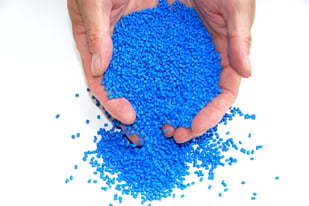 The terms ‘thermoplastic’ and ‘thermoset’ are used frequently to classify different plastic materials. So what exactly is the difference? The main characteristic that separates the two types of materials is their response to heat - one can be re-melted from a solid back into a liquid state, while the other will remain permanently in a solid state.
The terms ‘thermoplastic’ and ‘thermoset’ are used frequently to classify different plastic materials. So what exactly is the difference? The main characteristic that separates the two types of materials is their response to heat - one can be re-melted from a solid back into a liquid state, while the other will remain permanently in a solid state.
Continue reading to learn more about the differences between these two types of materials:
Processing
Thermoplastic polymers can be considered ‘melt-processable’ plastics, or materials that can be processed with the application of heat. When heat brings the temperature of the material above its melt point, the plastic liquefies to the point where it can be molded and processed. When the heat source is removed, the temperature of the plastic drops and it cools and solidifies into the desired shape.
 During the plastic sheet extrusion process, for example, a solid resin pellet is fed through the hopper, into the barrel of the extrusion line and heated to a liquid state. The liquid polymer material is then fed through a die, where it is shaped into the form of a sheet, fed through a three-roll stack, and cooled. Examples of this type of material include polyethylene, polypropylene, and polystyrene among others, all of which Impact Plastics extrudes.
During the plastic sheet extrusion process, for example, a solid resin pellet is fed through the hopper, into the barrel of the extrusion line and heated to a liquid state. The liquid polymer material is then fed through a die, where it is shaped into the form of a sheet, fed through a three-roll stack, and cooled. Examples of this type of material include polyethylene, polypropylene, and polystyrene among others, all of which Impact Plastics extrudes.
Thermoset polymers, in contrast, undergo a chemical reaction that is irreversible as they transition from liquid to solid form. The process through which these materials solidify is called “curing.” In it's uncured form, the material has very small unlinked molecules (monomers), and through the addition of a catalyst and/or heat a chemical reaction is initiated. During this chemical reaction the molecules cross-link to form longer molecular chains causing the material to solidify permanently. Examples of this type of material include epoxy, polyester, polyurethane, silicone and polyamide. Thermosets can offer improved mechanical properties such as, enhanced chemical resistance, heat resistance and structural integrity in thin and thick wall applications.
Reprocessing
When thermoplastics undergo the transition from liquid to solid state, no chemical reaction takes place and the change seen in these materials is purely physical, not chemical. As such, the solid state is completely reversible through the application of heat, allowing these materials to be re-molded and recycled without negatively affecting the material’s physical properties.
One caveat to reprocessing this type of material, however, is what is known as the heat history of the material. While thermoplastics can be recycled and reprocessed, with each time the material undergoes heat, or with each heat history, the material is increasingly subject to deterioration. As a result there is a limit to the number of times that a material can be reprocessed before it becomes subject to degradation and properties begin to suffer.
As mentioned above, when a thermoset polymer transition from a liquid to a solid state, an irreversible chemical reaction takes place as the molecules cross-link and the material to permanently solidifies. As a result, further applications of heat will cause the material to degrade, but not melt, making them excellent materials for high-heat applications such as electronics and appliances.
Recycling
Because thermoplastic polymers can be re-heated and reprocessed, the materials can be recycled and ultimately diverted for re-use into other applications. The ability to recycle and reprocess this type of polymer is what allows Impact to offer recycled grades of the materials we extrude, providing our customers with an economical and environmentally friendly alternative to virgin resins.
In contrast, thermosets cannot be recycled and due to the permanent nature of the chemical bonds formed during the curing process.
For more information on our product offering, contact out team today for a material consultation!




